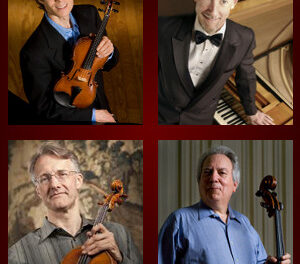Works by Brahms and Rachmaninov received their full Romantic due at the Eastern Music Festival’s July 8 concert in a packed Dana Auditorium. Guest conductor Andreas Delfs, now in his ninth year as Music Director of the Milwaukee Symphony Orchestra, secured every measure of plush string tone from the all-faculty Eastern Philharmonic and stitched it into a seamless stream of melody. The woodwinds and brass were welded into a rich harmony to match. When appropriate, he conjured up a solid full orchestral texture that sounded as if there were 20% more players on stage. Quiet passages had the airiness of chamber music. Delfs is a musician who will be going places.
Brahms’ Symphony No. 3 in F, Op. 90, is his most compact work in this form. While a genial warmth radiates from the whole piece, his characteristic autumnal melancholy dominates the third movement. A host of commentators have made much of the symphony as a huge statement of a private motto, Frei aber froh (free but happy), reflected in the F-A-F melodic motif that opens the piece. Brahms’ motto was a response to Joachim’s more realistic monogram, Frei aber einsam (free but alone). As Steven Ledbetter’s program notes point out, the entire symphony works on “an expressive scheme that is constantly playing with the opposition between major and minor.” It is too bad that it ends pianissimo. A quiet ending almost always precludes a standing ovation.
Delfs and his musicians certainly deserved a standing ovation for their intense and tightly-organized performance. Without blurring intonation, the strings purred richly and blended beautifully with the wonderfully warm brass and woodwind. Prominent and fine solos were given by clarinetist Shannon Scott, principal horn Leslie Norton, and oboist Randall Ellis.
André Watts has long been a favorite of Triangle and Triad audiences, having often appeared as both a recitalist and a concerto soloist. A substantial Liszt recital for the defunct Friends of the College will be long remembered, as will a complete Beethoven piano concerto cycle that managed to survive both an ice storm and the artist’s flu attack. He still has plenty of power, as was evident as he pounced on the keys in the loudest parts of Rachmaninov’s Piano Concerto No. 2 in c minor, Op. 18. But he found plenty of poetry in the soft opening of the concerto and the many delicate and introspective moments in the other two movements. At times he played like a chamber musician as he took part, dialogue-like, with orchestra soloists or, in several cases, with the entire viola section, playing as one. The EMF audience roared its approval with a prolonged standing ovation and many recalls for Watts – and cheers, too, for the orchestra soloists, acknowledged by Delfs. Having given so much, Watts eschewed an encore.
The many exposed parts for the violas are a thank you to a physician, Dr. Nikolai Dahl, an amateur violist whose radical treatment – a mixture of hypnosis and positive thinking – helped cure Rachmaninov’s crisis of compositional confidence. The abysmal failure of the premiere of his First Symphony had left him with composer’s block. Overcoming this creative obstacle marked a pivotal change in the composer’s style. According to Michael Steinberg, in The Concerto, “Stravinsky, with little liking, described the change in Rachmaninov at this time as one from watercolors to oils, from a very young composer to a very old one.” His mature Romantic style has won the vote of generations of listeners despite the snobbery of many music critics.











